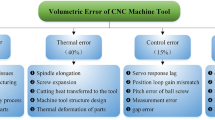Abstract
In this study, we present a methodology for minimizing machining time, where the surface roughness is constrained for the problem. The objective of the methodology is to encounter optimized cutting parameters which reduce machining time without reducing the surface quality of the machined workpiece. Three optimization schemes were considered to encounter the minima of a quantity which is a function of machining parameters: (a) sequential quadratic programming, (b) genetic algorithms, and (c) simulated annealing. For the discussion of the methodologies employed, an example of a machined surface is presented. The formalisms are used to obtain the parameters which minimize the machining time while maintaining the surface roughness within acceptable limits.
Similar content being viewed by others
References
Haftka RT, Gurdal Z (1992) Elements of structural optimization, 3rd edn. Springer, Berlin
Martellotti ME (1941) An analysis of the milling process. Trans ASME 63:667–700
Martellotti ME (1945) An analysis of the milling process, part II—Down milling. Trans ASME 67:233–251
Wan M, Zhang WH, Dang JW, Yang Y (2009) New procedures for calibration of instantaneous cutting force coefficients and cutter runout parameters in peripheral milling. Int J Mach Tools Manufact 49:1144–1151
Quintana G, Ciurana J, Ribatallada J (2010) Surface roughness generation and material removal rate in ball end milling operations. Mater Manuf Process 25:386–398
Elbestawi MA, Ismail F, Yuen KM (1994) Surface topography characterization in finish milling. Int J Mach Tools Manufact 34:245–255
Raja SB, Baskar N (2010) Optimization techniques for machining operations: a retrospective research based on various mathematical models. Int J Adv Manuf Technol 48:1075–1090
Choi BK, Park JW, Jun CS (1993) Cutter-location data optimization in 5-axis surface machining. Comput Aided Des 25:377–386
Jung TS, Yang MY, Lee KJ (2005) A new approach to analysing machined surfaces by ball-end milling, part I. Int J Adv Manuf Technol 25:833–840
Jung TS, Yang MY, Lee KJ (2005) A new approach to analysing machined surfaces by ball-end milling, part II. Int J Adv Manuf Technol 25:841
Tournier C, Duc E (2002) A surface based approach for constant scallop height tool-path generation. Int J Adv Manuf Technol 19:318–324
Bouzakis KD, Aichouh P, Efstatiou K (2003) Determination of the chip geometry, cutting force and roughness in free form surfaces finishing milling, with ball end tools Int. J Mach Tools Manuf 43:499–514
Antoniadis A, Savakis C, Bilalis N, Balouktsis A (2003) Prediction of surface topomorphy and roughness in ball end milling. Int J Adv Manuf Technol 21:965–971
Gao T, Zhang WH, Qiu KP, Wan M (2006) Numerical simulation of machined surface topography and roughness in milling process. ASME J Manuf Sci Eng 128:96–103
Belegundu D, Chandrupatla TR (1999) Optimization concepts and applications in engineering. Prentice Hall, Upper Saddle River
Dostál Z (2009) Optimal quadratic programming algorithms. Springer, Berlin
Holland JH (1975) Adaptation in natural and artificial systems. University of Michigan Press, Ann Arbor
Kirkpatrick S, Gelatt CD Jr, Vecchi MP (1983) Optimization by simulated annealing. Science 220:671–680
Bet L (1999) Estudo da Medição da Textura de Superfícies Com Sondas Mecânicas e Sondas Ópticas Tipo Seguidor. Ph.D. thesis (Mechanical Engineering), Universidade Federal de Santa Catarina
Goldberg DE (1989) Genetic algorithms in search, optimization and machine learning. Addison-Wesley, Reading
Rothlauf F (2006) Representations for genetic and evolutionary algorithms, 2nd edn. Springer, Berlin
Riolo R, O'Reilly U, McConaghy T (2010) Genetic programming theory and practice VII. Springer, Berlin
Zalzala AMS, Fleming PJ (eds) (1997) Genetic algorithms in engineering systems. The Institution of Electrical Engineers, London
Chen JC, Zhong TX (2002) A hybrid-coded genetic algorithm based optimisation of non-productive paths in CNC machining. Int J Adv Manuf Technol 20:163–168
Author information
Authors and Affiliations
Corresponding author
Rights and permissions
About this article
Cite this article
Corso, L.L., Zeilmann, R.P., Nicola, G.L. et al. Using optimization procedures to minimize machining time while maintaining surface quality. Int J Adv Manuf Technol 65, 1659–1667 (2013). https://doi.org/10.1007/s00170-012-4288-8
Received:
Accepted:
Published:
Issue Date:
DOI: https://doi.org/10.1007/s00170-012-4288-8




